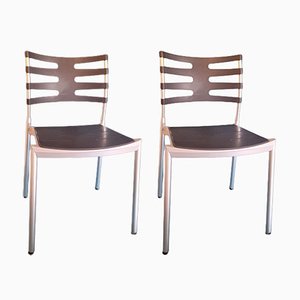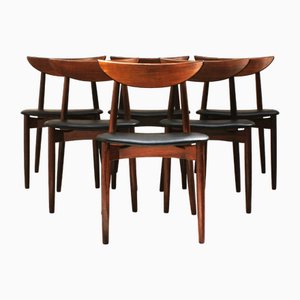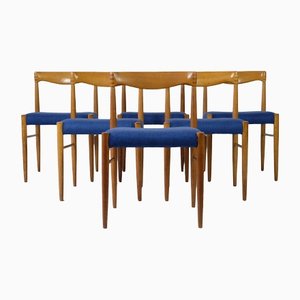Automatisch generierte Übersetzung
Original anzeigen
Übersetzung anzeigen
Set of four dining chairs with a frame in black lacquered metal and seat in curved plywood, attributed to Carlo Ratti and produced by Società Compensati Curvati in the 1950s.
In Italy, at the beginning of the XX century, industries of curved solid wood arose under license of Michael Thonet, and through the International Exhibitions the processing of curved wood became more and more widespread.
The Expo of the first decade was also attended by the wood manufacturers of Monza, while in 1905 Otto Helzer, in Switzerland, patented wooden structures in curved laminated, whose strength was equivalent to those in steel.
The Ratti brothers of Monza took their cue from the solid wood laminate to create furniture that, instead of wooden elements, used sheets of wood.
The brothers Ratti, Carlo and Mario, also began to follow the young artistic avant-gardes (cubism, futurism and abstractionism).
The mastery of wooden sculpture influenced Carlo in the design and realization of furniture of fine neo-plastic artistic workmanship and decò, receiving honors from the Prince of Piedmont Umberto di Savoia.
In 1919, in Milan, the first Lombard Exhibition of Decorative Arts was set up (later to become the Triennale) and the Ratti brothers exhibited their furniture in solid wood but also in curved panel with a new system of curvature, the one in Telo.
The canvas system was developed by the Ratti brothers with the help of a friend, Cesare Cantù.
They developed an elastomer bag in which the mould was inserted with the panel to be bent and, closing it with clamps, the air inside was removed, thus making the panel adhere to the mould.
Carlo and Mario found in the Telo system a means by which they could make objects and furniture in the three spatial directions with large surface curvatures, without limits of thickness and minimum radii of curvature.
In 1921 in Stuttgart the first Salone del Mobile was inaugurated and the Fratelli Ratti of Monza made itself known internationally by presenting solid wood furniture and also furniture in load-bearing plywood, flanked by furniture with framed and interchangeable covers.
The Expo became meeting places to verify and present the novelties in the furniture and industrialization sector and, with the development of Industrial Design, the first architects joined in the design of the furniture industries.
The Ratti Brothers, in the various international and national exhibitions, also presented incredible objects in their realization with the system in Telo.
After 1930 Carlo and Mario produced many containers for radio and folding chairs for cinema but in 1939 they divided and in Monza Mario remained who, with his sons Antonio and Angela, formed the Società Compensati Curvi.
Carlo moved to Lissone, forming with his sons Angelo and Piera and with her husband, Piero Berruti, the Industria Legni Curvati. After the war, a new bending system, the Mould and Counter-mould, was added to the existing systems from the 1950s.
After the war, the architects devoted themselves exclusively to the planning and reconstruction of the territory and the need to regain the markets put the industrialists in conditions to offer quality products, designed by architects-designers of the new generation.
Both Carlo Ratti’s and Mario’s firm began collaborating with world-famous architects such as Ignazio Gardella, Paolo Chessa, Vico Magistretti, the Castiglioni brothers, Vittoriano Vigano, Marco Zanuso, Carlo de Carli, etc.
In those years many technological objects were made with curved plywood bodies such as washing machines, televisions, radios, sewing machines, etc. while the production of furniture in a rationalistic style continued.
The new bending technologies, Mould and Counter-mould and High Frequency, allowed a remarkable mass production and, if the old system in Telo continued to exist to make extraordinary objects with Coons curves, especially the High Frequency spread all over the world.
The Japanese company Tendo Mokko invented this new bending system in 1948, trying to make plywood planes and, immediately, the company Ratti of Monza used it, while that of Lissone continued to make products with the old Mould and Counter-mould system.
This system used aluminum shapes unlike other systems that, instead, made wooden shapes, with considerable economic savings.
In 1954 a chair designed by Carlo de Carli for Cassina and made by Carlo Ratti won the "Compasso d'Oro" award as an object of considerable technical and aesthetic value.
In 1961 Carlo Ratti died and his sons Angelo and Piera, with her husband Piero Berruti, continued the activity while the third generation was entering the company.
The company transformed from Industria Legni Curvati into Carlo Ratti s.a.s and, since then, new collaborations with young architects allowed a new technological development.
Thus, the High Frequency system was introduced in the company, but the Mould and Counter-mould system was not abandoned and, above all, the Telo system that was still used for the production of samples and prototypes.
Satz von vier Esszimmerstühlen mit einem Gestell aus schwarz lackiertem Metall und einer Sitzfläche aus gebogenem Sperrholz, die Carlo Ratti zugeschrieben und von der Società Compensati Curvati in den 1950er Jahren hergestellt wurden.
Jahrhunderts entstand in Italien die Industrie für gebogenes Massivholz unter der Lizenz von Michael Thonet, und durch die internationalen Ausstellungen wurde die Verarbeitung von gebogenem Holz immer mehr verbreitet.
Die Expo des ersten Jahrzehnts wurde auch von den Holzherstellern von Monza besucht, während 1905 Otto Helzer in der Schweiz Holzstrukturen aus gebogenem Schichtholz patentierte, deren Festigkeit der von Stahl gleichkam.
Die Gebrüder Ratti aus Monza nahmen sich das Massivholzlaminat zum Vorbild, um Möbel zu entwerfen, bei denen anstelle von Holzelementen Platten aus Holz verwendet wurden.
Die Brüder Ratti, Carlo und Mario, begannen auch, die jungen künstlerischen Avantgarden (Kubismus, Futurismus und Abstraktionismus) zu verfolgen.
Die Beherrschung der Holzskulptur beeinflusste Carlo bei der Planung und Realisierung von Möbeln in feiner neoplastischer Kunstfertigkeit und Decò, wofür er vom piemontesischen Fürsten Umberto di Savoia ausgezeichnet wurde.
1919 wurde in Mailand die erste lombardische Kunstgewerbeausstellung (die spätere Triennale) veranstaltet, auf der die Brüder Ratti ihre Möbel aus Massivholz, aber auch aus gewölbten Platten mit einem neuen Wölbungssystem, dem von Telo, ausstellten.
Das Segeltuchsystem wurde von den Brüdern Ratti mit der Hilfe eines Freundes, Cesare Cantù, entwickelt.
Sie entwickelten einen Elastomerbehälter, in den die Form mit der zu biegenden Platte eingelegt wurde und der mit Klammern verschlossen wurde, um die Luft im Inneren zu entfernen und die Platte an der Form haften zu lassen.
Carlo und Mario fanden in dem Telo-System ein Mittel, mit dem sie Objekte und Möbel in den drei Raumrichtungen mit großen Oberflächenkrümmungen, ohne Begrenzung der Dicke und minimalen Krümmungsradien herstellen konnten.
1921 wurde in Stuttgart der erste Salone del Mobile eröffnet und die Fratelli Ratti aus Monza machten sich international einen Namen, indem sie Möbel aus Massivholz und auch Möbel aus tragendem Sperrholz präsentierten, flankiert von Möbeln mit gerahmten und austauschbaren Bezügen.
Die Expo wurde zum Treffpunkt, um die Neuheiten im Bereich der Möbel und der Industrialisierung zu prüfen und zu präsentieren, und mit der Entwicklung des Industriedesigns beteiligten sich die ersten Architekten an der Gestaltung der Möbelindustrie.
Die Gebrüder Ratti präsentierten auf den verschiedenen internationalen und nationalen Ausstellungen auch unglaubliche Objekte, die sie mit dem System von Telo realisiert hatten.
Nach 1930 produzierten Carlo und Mario viele Behälter für das Radio und Klappstühle für das Kino, aber 1939 trennten sie sich und in Monza blieb Mario, der mit seinen Söhnen Antonio und Angela die Società Compensati Curvi gründete.
Carlo zog nach Lissone und gründete mit seinen Söhnen Angelo und Piera sowie mit ihrem Mann Piero Berruti die Industria Legni Curvati. Nach dem Krieg kommt zu den bestehenden Systemen aus den 1950er Jahren ein neues Biegesystem, die Form und Gegenform, hinzu.
Nach dem Krieg widmeten sich die Architekten ausschließlich der Planung und dem Wiederaufbau des Gebiets, und die Notwendigkeit, die Märkte wieder zu erobern, versetzte die Industriellen in die Lage, Qualitätsprodukte anzubieten, die von Architekten und Designern der neuen Generation entworfen wurden.
Sowohl die Firma von Carlo Ratti als auch die von Mario begannen, mit weltberühmten Architekten wie Ignazio Gardella, Paolo Chessa, Vico Magistretti, den Brüdern Castiglioni, Vittoriano Vigano, Marco Zanuso, Carlo de Carli usw. zusammenzuarbeiten.
In jenen Jahren wurden viele technische Gegenstände mit gebogenen Sperrholzkörpern hergestellt, wie Waschmaschinen, Fernsehgeräte, Radios, Nähmaschinen usw., während die Produktion von Möbeln im rationalistischen Stil weiterging.
Die neuen Biegetechnologien, Mould and Counter-mould und High Frequency, ermöglichten eine bemerkenswerte Massenproduktion, und wenn das alte System in Telo weiter existierte, um außergewöhnliche Objekte mit Coons-Kurven herzustellen, verbreitete sich vor allem die High Frequency über die ganze Welt.
Die japanische Firma Tendo Mokko erfand dieses neue Biegesystem 1948 für die Herstellung von Sperrholzhobeln, und die Firma Ratti in Monza setzte es sofort ein, während die Firma Lissone weiterhin Produkte mit dem alten System aus Form und Gegenform herstellte.
Dieses System verwendete Aluminiumformen im Gegensatz zu anderen Systemen, die stattdessen Holzformen herstellten, was zu erheblichen wirtschaftlichen Einsparungen führte.
1954 wurde ein von Carlo de Carli für Cassina entworfener und von Carlo Ratti hergestellter Stuhl mit dem "Compasso d'Oro" als Objekt von hohem technischen und ästhetischen Wert ausgezeichnet.
1961 starb Carlo Ratti, und seine Söhne Angelo und Piera setzten zusammen mit ihrem Mann Piero Berruti die Tätigkeit fort, während die dritte Generation in das Unternehmen eintrat.
Das Unternehmen wird von Industria Legni Curvati in Carlo Ratti s.a.s. umgewandelt, und seitdem ermöglichen neue Kooperationen mit jungen Architekten eine neue technologische Entwicklung.
So wurde das Hochfrequenzsystem im Unternehmen eingeführt, aber das System von Form und Gegenform wurde nicht aufgegeben und vor allem das Telo-System, das weiterhin für die Herstellung von Mustern und Prototypen verwendet wurde.




Schreiben Sie uns
Ein Angebot machen
Uns ist aufgefallen, dass Sie neu bei Pamono sind!
Bitte akzeptieren Sie die Allgemeinen Geschäftsbedingungen und die Datenschutzerklärung
Schreiben Sie uns
Ein Angebot machen
Fast geschafft!
Um die Kommunikation einsehen und verfolgen zu können, schließen Sie bitte Ihre Registrierung ab. Um mit Ihrem Angebot auf der Plattform fortzufahren, schließen Sie bitte die Registrierung ab.Erfolgreich
Vielen Dank für Ihre Anfrage! Unser Team meldet sich in Kürze bei Ihnen zurück.
Wenn Sie Architekt*in oder Inneneinrichter*in sind, bewerben Sie sich hier um dem Trage Program beizutreten.